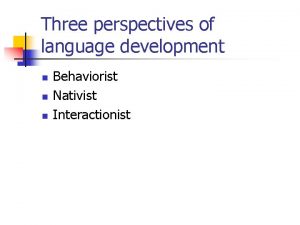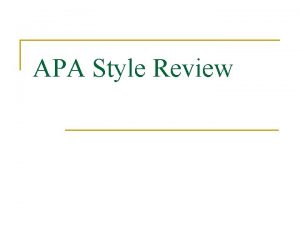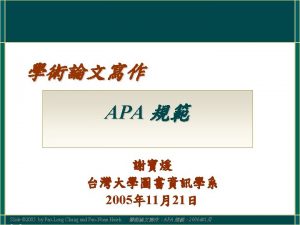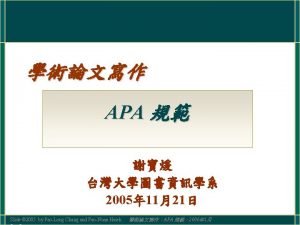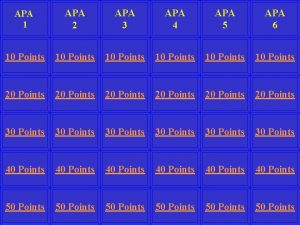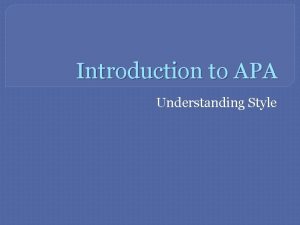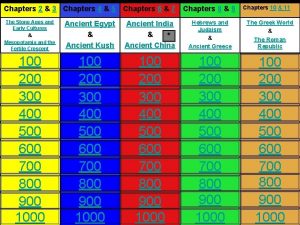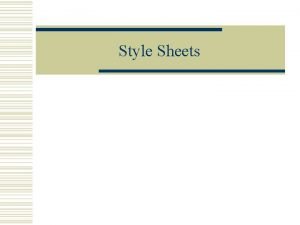Introduction to the APA Style APA Chapters 6














































- Slides: 46

Introduction to the APA Style APA Chapters 6 and 7 FSE 200

Outline • Crediting Sources • Reference Examples

APA Chapter 7 CREDITING SOURCES

When to Cite • Cite the work of those individuals whose ideas, theories, or research have directly influenced your work. • These sources may: – Provide background information – Support or dispute your thesis – Offer critical definitions or data • See Figure 6. 1

Plagiarism • Plagiarism is the presenting of “the work of another as if it were their own work” • Using other’s work is acceptable as long as it is appropriately cited. • This can include: – Paraphrasing – Direct quotes – Description of an idea that influenced your work

Self Plagiarism • Yes, you can plagiarize yourself…. • This includes the presentation of “previously published work as though it were new”

IMPORTANT!!!! ENSURE YOU HAVE READ AND UNDERSTAND THE PROVISIONS IN SECTIONS 7. 01 -7. 10

One work One Author • APA journals use the author-date method of citation. • This is the surname of the author (do not include suffixes such as Jr. ) and the year of publication. • The citation in the text will be inserted at the appropriate point, for example: – Walker (2000) compared reaction times – In a recent study of reaction times (Walker, 2000)

One work One Author • If the name of the author appears as a part of the narrative, as in the example given previously, cite only the year in parentheses. • Otherwise, place both the name and the year, separated by a comma, in parentheses.

One Work by Multiple Authors • When a work has two authors, always cite both names every time the reference occurs in text. • When a work has three, four, or five authors, cite all the authors the first time the reference occurs. • In subsequent citations, include only the surname of the first author followed by et al. (not italicized and with a period after “al”) • Exception: If two references with the same year shorten to the same form; cite the surnames of the first authors and of as many of the subsequent authors as necessary to distinguish the two references, followed by a comma and et al.

One Work by Multiple Authors • When a work has six or more authors, cite only the surname of the first author followed by et al. • In the reference list, however, because et al. translates to “and authors, ” a decision was made to spell out the six authors and seven authors and to use et al. after the sixth author for eight or more authors. ) • Join the names in multiple-author citation in running text by the word and.

Groups as Authors • The names of groups that serves as authors (e. g. , corporations, associations, government agencies, and study groups) are usually spelled out each time they appear in the text citation. • The names of some group authors (e. g. , associations, government agencies) are spelled out in the first citation and abbreviated thereafter.

Works with No Author (Including Legal Materials) or with an Anonymous Author • When a work has no author, cite in the text the first few words of the reference list entry (usually the title) and the year. • Use double quotation marks around the title of an article or chapter, and italicize the title of the periodical, book, brochure, or report. • When a work’s author is designated as “Anonymous” cite in the text the word Anonymous followed by a comma and a date.

Two or More Works Within the Same Parentheses • Order the citations of two or more works within the same parentheses in the same order in which they appear in the reference. • Arrange two or more works by the same authors (in the same order) by year of publication. • Identify works by the same author (or by the same two or more authors in the same order) with the same publication date by the suffixes a, b, c, and so forth after the year; repeat the year.

Two or More Works Within the Same Parentheses • List two or more works by different authors who are cited within the same parentheses in alphabetical order by the first author’s surname. • Separate the citations with semicolons: – Several studies (Balda, 1980; Kamil, 1988; Pepperburg and Funk, 1990).

Classical Works and Specific Parts of a Source • Classical Works: • Reference entries are not required for major classical works, such as ancient Greek and Roman works and the Bible. • Specific Parts of a Source: • To cite a specific part of a source, indicate the page, chapter, figure, table, or equation at the appropriate point in text. • Always give page numbers for quotations, for example: – (Cheek & Buss, 1981, p. 332)

Personal Communications and Citations in Parenthetical Material • Personal Communications • Because they do not provide recoverable data, personal communications are not included in the reference list. • Cite personal communications in text only. • Citations in Parenthetical Material: • In a citation that appears in parenthetical text, use commas (not brackets) to set off the date: – (see Table 2 of Hashtroudi, Chrosniak, & Schwartz, 1991, for complete data)

Reference List and References to Legal Materials • Reference List • Authors should choose references judiciously. • It must include only the sources that were used in the research and preparation of the article. • References to Legal Materials • Legal periodicals and APA journals differ in the placement and format of references. • The main difference is that legal periodicals cite the references in footnotes, whereas APA journals locate all references, including references to legal materials, in the reference list.

Construction of an Accurate and Complete Reference List • Each entry usually contains the following elements: author, year of publication, title, and publishing data. • All of the information necessary for unique identification and library search. • APA Reference Style • Publisher’s Location: Give the location (city and state for U. S. publishers, city, state, or province if applicable, and country for publishers outside of the United States). • Arabic Numerals: APA journals use arabic numerals (e. g. , Vol. 3, not Vol. III) because they use less space and are easier to comprehend than roman numerals.

Order of References in the Reference List • Alphabetize letter by letter. Remember however, that “nothing precedes something” • Alphabetize the prefixes M’, Mc, and Mac literally, not as if they were all spelled Mac. • Alphabetize surnames that contain articles and prepositions (de, la, du, von, etc. ) according to the rules of the language of origin. • The biographical section of Merriam-Webster’s Collegiate Dictionary is a helpful guide on surnames with articles or prepositions.

Order of Several Works by the Same First Author • When ordering several works by the same first name of the author, give author’s name in the first and all subsequent references, and use the following rules to arrange the entries: – One author entries by the same author are arranged by year of publication, the earliest first. – References with the same first author and different second or third authors are arranged alphabetically by the surname of the second author, or if the second author is the same, then by the surname of the third author.

Order of Several Works by the Same First Author • Rules Continued – References with the same authors in the same order are arranged by year of publication, the earliest first. – References by the same author (or by the same two or more authors in the same order) with the same publication date arranged alphabetically b the title (excluding A or The) that follows the date. – Lowercase letter—a, b, c, and so on– are placed immediately after the year, within the parentheses.

Order of Several Works With Groups Authors or With No Authors • Alphabetize group authors, such as associations or government agencies, by the first significant word of the name. • Full official names should be used. • A parent body precedes a subdivision. • If, and only if, the work is signed “Anonymous, ” the entry begins with the word Anonymous spelled out. • If there is no author, the title moves to the author position, and the entry is alphabetized by the first significant word of the title.

References Included in a Meta-Analysis and General Forms Integrate the studies alphabetically within the references section Then identify each by preceding it with an asterisk. General Forms Periodicals include items published on a regular basis: Journals, magazines, scholarly newsletters, and so on. • Nonperiodicals include items published separately: books, reports, brochures, certain monographs, manuals, and audiovisual media. • Electronic sources include aggregated databases, online journals, web sites or web pages, newsgroups, web-or e-mail based discussion groups, and Web-or e-mail based newsletters. • •

Authors • Periodical: – Kernis, M. H. , Cornell, D. P. , Berry, A. , & Harlow, T. • Nonperiodical: – Robinson, D. N. (Ed. ). • Invert all authors’ names; give surnames and initials for only up to and including seven authors. • When eight or more, abbreviate the seventh and subsequent authors as et al. • Spell out the full name of a group author • In reference to an edited book, place the editors’ names in the author position, and enclose the abbreviation Ed. or Eds. In parentheses after the last editor’s name.

Publication Date • Give in the parentheses the year the work was copyrighted (for unpublished works, give the year the work was produced). • For magazines, newsletters, and newspapers, give the year followed by the exact date on the publication. • For papers and posters presented at meetings, give the year and month of the meeting, separated by a comma and enclosed in parentheses. • If no date is available, write n. d. in parentheses.

Title of Article or Chapter • Periodicals: – Author (Year). Husbands at home: Predictors of paternal presentation in childcare and housework. • Nonperiodicals: – Author (Year). Men’s and women’s gender role journeys: Metaphors for healing, transition, and transformation • Capitalize only the first word of the title and of the subtitle, if any, and any proper nouns; do not italicize the title or place quotation marks around it.

Title of Work and Publication Information: Periodicals • • Journal: – Buss, D. M. (1993). Sexual strategies theory: evolutionary perspective on human Psychological Review, 100, 204 -232 Magazine: An mating. – Give title in full, in uppercase and lowercase letters. – Give the volume number of journals, magazine, and newsletters. Do not use Vol. before the number. – If a journal or newsletter does not use volume numbers, include the month, season, or other designation with the year. – Give inclusive page numbers. Use pp. in reference to newspapers.

Title of Works: Nonperiodicals • Capitalize only the first word of the title and of the subtitle, if any, and any proper nouns; italicize the title. • Enclose additional information given on the publication for its identification and retrieval (e. g. , edition, report number, volume number) in parentheses immediately after the title.

Title of Works: Part of a Nonperiodical (Book Chapters) • The title element for an edited book consists of the name of the editor preceded by the word In and (b) the book title with parenthetical information. • Because the editor’s name is not in the author position, do not invert the name; use initials and surname. • With two names, use & before the second surname, and do not use commas to separate the names. • Identify the editor by the abbreviation Ed. In parentheses after the surname. • For a book with no editor, simply include the word In before the book title.

Publication Information: Nonperiodicals • Give the city, state, and if the city is not well known for publishing or could be confused with another location, the state or province where the publisher is located as noted on the title of the book. • If two or more publishers locations are given, give the location listed first.

Retrieval Information: Electronic Sources • If information obtained from document on the internet, provide internet address for the document at the end of the retrieval statement. • If information is from aggregated database, the name of the database is sufficient, no address needed.

APA Chapter 8 REFERENCE EXAMPLES

References • Periodicals • Herman, L. M. , Kuczaj, S. A. , III, & Holder, M. D. (1993). Responses to anomalous gestural sequences by a language-trained: Evidence for processing the semantic relations and syntactic information. Journal of Experimental Psychology, 122, 184 -194.

References • Journal article, one author • Mellers, B. A. (2000). Choice and the relative pleasures of consequences. Psychological Bulletin, 126, 910 -924.

References • Journal Article, two authors, journal paginated by issue • Klimoski, R. , & Palmer, S. (1993). The ADA and the hiring process in organizations. Consulting Psychology Journal: Practice and Research, 45 (2), 10 -36.

References • Journal Article, three to seven authors • Saywitz, K. J. , Mannarino, A. P. , Berliner, L. , & Cohen, J. A. (2000). Treatment for sexually abused children and adolescents. American Psychologist, 55, 1040 -1049.

References • Magazine article • Kandel, E. R. , & Squire, L. R. (2000, November 10). Neuroscience: Breaking down scientific barriers to the study of the brain and mind. Science, 290, 1113 -1120. • Newsletter article • Brown, L. S. (1993, Spring). Antidomination training as a central component of diversity in clinical psychology education. The Clinical Psychologist, 46, 83 -87.

References • References to entire books • Beck, C. A. J. , & Sales, B. D. (2001). Family mediation: Facts, myths, and future prospects. Washington, D. C. : American Psychological Association. • Mitchell, T. R. , & Larson, J. R. , Jr. (1987). People in organizations: An introduction to organizational behavior (3 rd ed. ). New York: Mc. Graw-Hill.

References • Book, group author (government agency) as publisher • Australian Bureau of Statistics. (1991). Estimated resident population by age and sex in statistical local areas, New South, June 1990 (No. 3209. 1). Canberra, Australian Capital Territory: Author.

References • Edited Book • Gibbs, J. T. , & Huang, L. N. (Eds. ). (1991). Children of color: Psychological interventions with minority youth. San Francisco: Jossey-Bass.

References • Article or chapter in an edited book • Massaro, D. (1992). Broadening the domain of the fuzzy logical mode of perception. In H. L. Pick Jr. , van den Boek, & D. C. Knill (Eds. ), Cognition: Conceptual and methodological issues (pp. 51 -84). Washington, D. C. : American Psychological Association.

References • Report available from the Educational Resource Information Center (ERIC) • Mead, J. V. (1992). Looking at old photographs: Investigating the teacher tales that novice teachers bring them. (Report No. NCRTL-RR-92 -4). East Lansing, MI: National Center for Research on Teacher Learning. (ERIC Document Reproduction Service No. ED 346082)

References • Electronic copy of a journal article, three to five authors, retrieved from database • Borman, W. C. , Hanson, M. A. , Oppler, S. H. , Pulakos, E. D. , & White, L. A. (1993). Role of early supervisory experience in supervisor performance. Journal of Applied Psychology, 78, 443 -449. Retrieved October 23, 2000, from the Psy. ARTICLES database.

References • Electronic version of U. S. government report available by search from GPO Access database (on the Web) • U. S. General Accounting Office. (1997, February). Telemedicine: Federal strategy is needed to guide investments (Publication No. GAO/NSAID/HEHS-9767). Retrieved September 15, 2000, General Accounting Office Reports Online via GPO Access: http: //www. access. gpo. gov

Acknowledgement Thanks to Dr. David May for much of the contents of this presentation.
 Apa chapters
Apa chapters Open punctuation block letter
Open punctuation block letter Formal writing vs informal writing
Formal writing vs informal writing Formal writing vs informal writing
Formal writing vs informal writing Nnn speech
Nnn speech Puritan plain style examples
Puritan plain style examples Cumulative periodic and inverted sentences
Cumulative periodic and inverted sentences Hình ảnh bộ gõ cơ thể búng tay
Hình ảnh bộ gõ cơ thể búng tay Lp html
Lp html Bổ thể
Bổ thể Tỉ lệ cơ thể trẻ em
Tỉ lệ cơ thể trẻ em Gấu đi như thế nào
Gấu đi như thế nào Tư thế worm breton
Tư thế worm breton Hát lên người ơi alleluia
Hát lên người ơi alleluia Các môn thể thao bắt đầu bằng tiếng bóng
Các môn thể thao bắt đầu bằng tiếng bóng Thế nào là hệ số cao nhất
Thế nào là hệ số cao nhất Các châu lục và đại dương trên thế giới
Các châu lục và đại dương trên thế giới Công thức tính độ biến thiên đông lượng
Công thức tính độ biến thiên đông lượng Trời xanh đây là của chúng ta thể thơ
Trời xanh đây là của chúng ta thể thơ Mật thư tọa độ 5x5
Mật thư tọa độ 5x5 Làm thế nào để 102-1=99
Làm thế nào để 102-1=99 độ dài liên kết
độ dài liên kết Các châu lục và đại dương trên thế giới
Các châu lục và đại dương trên thế giới Thể thơ truyền thống
Thể thơ truyền thống Quá trình desamine hóa có thể tạo ra
Quá trình desamine hóa có thể tạo ra Một số thể thơ truyền thống
Một số thể thơ truyền thống Cái miệng nó xinh thế
Cái miệng nó xinh thế Vẽ hình chiếu vuông góc của vật thể sau
Vẽ hình chiếu vuông góc của vật thể sau Thế nào là sự mỏi cơ
Thế nào là sự mỏi cơ đặc điểm cơ thể của người tối cổ
đặc điểm cơ thể của người tối cổ Giọng cùng tên là
Giọng cùng tên là Vẽ hình chiếu đứng bằng cạnh của vật thể
Vẽ hình chiếu đứng bằng cạnh của vật thể Tia chieu sa te
Tia chieu sa te Thẻ vin
Thẻ vin đại từ thay thế
đại từ thay thế điện thế nghỉ
điện thế nghỉ Tư thế ngồi viết
Tư thế ngồi viết Diễn thế sinh thái là
Diễn thế sinh thái là Dot
Dot Các số nguyên tố
Các số nguyên tố Tư thế ngồi viết
Tư thế ngồi viết Lời thề hippocrates
Lời thề hippocrates Thiếu nhi thế giới liên hoan
Thiếu nhi thế giới liên hoan ưu thế lai là gì
ưu thế lai là gì Hổ đẻ mỗi lứa mấy con
Hổ đẻ mỗi lứa mấy con Khi nào hổ con có thể sống độc lập
Khi nào hổ con có thể sống độc lập Hệ hô hấp
Hệ hô hấp




